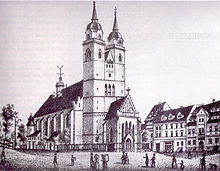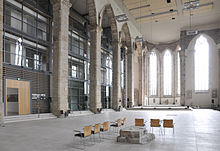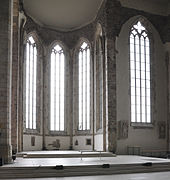St. John's Church (Magdeburg)
The St. Johannis Church in Magdeburg is a former church building in the Old Town district . It was consecrated to the Evangelist Johannes and has been used as a ballroom and concert hall for the city of Magdeburg since 1999. From January to June 2014 it served as a conference venue for the state parliament of Saxony-Anhalt .
history
Construction and first destruction in 1207
The exact date of the laying of the foundation stone is not known. In contrast, it is said that the first parish church was built in this area from 936–941 . It was mentioned for the first time on April 23, 941: King Otto I gave the monks of the Moritz monastery he founded a church known as plebeiam ecclesiam (People's Church). There are no representations or descriptions of this structure. With a document dated July 29, 946, the king once again confirmed the donation of a popularem ecclesiam . Thietmar von Merseburg mentioned the church in 1015 as a merchant church, aecclesia mercatorum . Historians assume that under Archbishop Hartwig in 1082 a new church was built on the previous site.
Abbot Arnold first mentioned the church as Sankt Johannis in 1160 in a document of Albrecht the Bear. In 1170 Archbishop Wichmann transferred the church to the monastery of Our Dear Women. Here the church is called ecclesiam forensem in Magdeborg in honore beati Johannis evangelistae consecratam (market church in Magdeburg, consecrated in honor of John the Evangelist).
After the church building had already been damaged in a town fire in 1188, it burned down in a new town fire in 1207.
Reconstruction and second destruction in 1451
Reconstruction began shortly after the devastating fire: first of all, the substructure of the tower floors was built, which was completed in 1213. The upper floors of the tower were built by 1218, and by 1238 the construction, including a tower house , was completed. The church was built in the style of a basilica . As early as 1239, a new major fire caused damage. In 1301 the Maccabees Monastery in Cologne exhibited the relic of the 11,000 virgins in the Johanniskirche.
On July 22nd, 1451 the north tower was struck by lightning. A fire broke out that also spread to the south tower and the nave. A third of the nave burned down and the house was no longer usable.
Reconstruction and third destruction in 1631
The reconstruction took place in the years 1452/1453, whereby instead of a basilica a three-aisled hall church with a vestibule was built on the west side. Ornamental forms were dispensed with. Instead Haustein came mainly dry stone used. The church roof was covered with copper , the towers with lead .
On June 26, 1524, the reformer Martin Luther preached in St. John's Church. Magdeburg then became Protestant .
During the Thirty Years' War on November 26, 1630 one of the spiers fell on the church roof as a result of a hurricane and caused considerable damage.
On the same day the imperial generalissimo Tilly decided in Hameln the attack on the besieged Magdeburg , which on May 10th July. / May 20, 1631 greg. took place. Magdeburg was captured and almost completely destroyed as a result of the outbreak of fires. Tilly's troops broke down the doors of the Johanniskirche, robbed the church and burned it down. Clergymen and members of the community were murdered.
Reconstruction and fourth destruction in 1945
The pastor of Sankt Johannis Petrus Hecht returned to Magdeburg in 1632 as the first pastor to return from captivity. He preached in Magdeburg Cathedral as the city churches had been destroyed.
It was not until 1641 that the church began to be cleared and the towers repaired. In 1642 Georg Kühlewein issued a decree to rebuild the Johanniskirche. The Seidensticker Johann Niesing and the rector Christian Wellmann made long trips in 1643 to bring in a collection for the reconstruction of the church, which also took them to Hamburg , Lübeck , Livonia , Riga , Breslau , Königsberg and Danzig . The collections lasted until 1645 and brought in 1311 thalers , 10 groschen and 3 pfennigs.
First, a temporary wooden church was built on the church grounds. The topping-out ceremony was celebrated on February 1, 1644, and a baptismal font was consecrated on May 10, 1648 .
By 1654 Magdeburg had recovered from the consequences of the war to such an extent that an orderly community life took place again. The wooden makeshift apartments gave way to real houses, and the community had its own income. In the years 1656/1657 a parsonage and sexton was built on the Johanniskirchhof .
From 1662 the actual reconstruction of the church began with the erection of individual pillars. On September 12, 1663 the official decision of the community took place. With the help of the first collection and the visible start of construction, further donations could be collected. The builder Heinrich Harder completed the construction work on November 25, 1669 .
In 1670 Tobias Wilhelmi created a new altar , which Christof Fensterer had decorated with pictures. On the 1st of Advent of the year the new St. John's Church was consecrated . The sermon was delivered by Ernestus Bake , son of the cathedral preacher Reinhard Bake .
In the following years further work took place, especially on the towers. In 1672 the towers were given welschen hoods . In 1674 the southern tower, made entirely of wood, was completed. The north tower followed in 1675, also largely made of wood. In 1676, Tobias Wilhelmi finally handed over the pulpit he had created .
With a fourth bell for St. Johannis and the two clock bells that were already there, the most comprehensive ringing of the city was created. In the north-east of the church, a stair tower to the roof structure was built in 1687.
An organ made between 1689 and 1695 in the workshop of the Hamburg organ builder Arp Schnitger , with an organ prospect by Tobias Wilhelmi, came onto the gallery of St. John's Church. However, for structural reasons, the gallery had to be renewed between 1748 and 1752.
On December 2, 1710, the sculptor Severin Gottlieb Ziegenbalg married in the Johanniskirche. In 1746 the composer Johann Heinrich Rolle became the organist here .
After the occupation of Magdeburg by French troops in 1806, the Johanniskirche temporarily served as a horse stable. In 1814 a service was held in the church on the occasion of the return of the Prussian army.


Only after more than 130 years, 1828–1831, was the first organ repair carried out. Between 1832 and 1850 the roof of the church was used by an official Prussian telegraph facility. 1868–1870 Wilhelm Sauer completely renewed the church instrument. In 1874, the electric fire alarm was introduced, which was watchman of the church released from his obligation to report the fire. Until then he had to indicate any fire and the direction of the fire.
In 1885 Wilhelm Faber became the first pastor at the church. In 1886 the Luther memorial created by Emil Hundrieser was inaugurated west of the church in memory of Martin Luther's sermon .
In 1892 the church windows got lead glazing and in 1900 the windows of the chancel got additional stained glass.
In the years that followed, technical innovations were the main features. A heating system was installed in 1892, which was replaced by low-pressure steam heating in 1928 . The organ, which was expanded in 1903/1904, received an electric wind system.
Electric lighting was introduced in 1923, and the Mourning Magdeburg Memorial was erected in the vestibule in 1924 .
On September 28, 1944, the St. John's Church suffered five heavy hits in an Allied air raid, which severely damaged the building. In the great air raid on Magdeburg on January 16, 1945 , the Johanniskirche was hit hard again, only the outer walls, the pillars of the central nave with the arches they carried, and the remains of the towers remained.
Reconstruction after the Second World War
The Johanniskirche remained in ruins for many years . It was not until 1953 that tidying up began in the western vestibule and by 1956 it was given a flat roof instead of the original vault. The towers were built, with the northern tower completely rebuilt and the southern tower merely secured. In Hettstedt and Wilhelmsburg , two bells of the Johanniskirche, which were actually retracted for war purposes, were found again, which were returned to the north tower of their destroyed church.
The repair work had not been carried out properly, so that the building police had the vestibule blocked in 1961. Because hardly any money was made available to the churches in the GDR , the St. John's Congregation donated the remains of the church and land to the city on August 22, 1968.
The city administration had the exterior walls restored from 1975 to 1977 and secured with a concrete ring anchor . On May 1, 1980, the south tower was opened to the public as an observation tower.
The sculptural ensemble Destruction and Reconstruction of the City of Magdeburg created by Heinrich Apel was installed in 1983 to decorate the vestibule portal. In 1989 the mourning Magdeburg received a seat again in the vestibule.
In 1987 the Protestant St. John's Congregation, which had existed until then, merged with the Luther Congregation to form the Trinity Congregation.
After the turn of the year 1989 and the end of the GDR, there were quick efforts to rebuild the church. On January 16, 1991 the board of trustees for the reconstruction of the Johanniskirche was founded . In 1991 the towers were sealed with a layer of lime cement mortar. Various cultural events took place in the ruins. The Magdeburg boys' choir sang Christmas carols under the direction of Frank Satzky in 1994, the Freie Kammerspiele performed the Luther piece The song wanted to get too high for my voice in 1996 .
In 1995 the original Luther memorial was rebuilt in front of the church.
Extensive reconstruction work followed, with the interior of the building combining history and modernity. Since its reopening on October 2, 1999, the building has been used as a concert and festival hall for the city of Magdeburg.
In 2004 the south tower was given a new top, financed by donations and with considerable support from the city, with which it reached a height of 69 m.
The last major part of the reconstruction began in 2014 with the artistic design of the Gothic windows in the nave. The Dresden artist Max Uhlig contrasts 6 colored windows on the south side with a simple choir room with grisaille . With a total of 14 windows covering an area of approx. 390 m², it is an outstanding work of art in terms of dimensions and manufacturing process. The project, financed by donations and subsidies, was completed in 2020.
Bells
In 1468 a master Heinrich cast the apostle bell .
In 1649, two bells cast by Georg Schreiber could be raised in the tower. In 1658 Georg Schreiber cast a festival bell using the melted remains of the old bells . In 1670, Jacob Wentzel re-cast the large bell (weight 6.5 t, diameter 2172 mm, strike tone g 0 ) that cracked in 1667 when the deceased Electress of Brandenburg was heard .
During the First World War , the Johanniskirche had to hand over a bell for armaments purposes in 1918. In 1927 the bells received an electric bell. In 1942, during the Second World War , the festival bell also had to be transported to a collection point.
Although the metal donation of the German people taken away, were both fixed bell and the smaller Bußglocke (percussive h 0 ) recovered and returned to the church building in Magdeburg 1954th However, they did not ring. It was only after the fall of the Wall that they could be restored and made to sound again; they could be heard again for the first time on October 31, 2008. In the future, you should ring the bell on the following occasions:
- Church events and special occasions
- Turn of the year
- Anniversary of the destruction of Magdeburg on January 16
- Anniversary of Otto von Guericke's death on May 11th (every five years)
- Commemoration of the reconstruction of St. John's Church with the construction of the south tower on May 12th (every five years)
- Reformation Day on October 31st
Worth seeing
- Martin Luther monument in front of the church
- The mourning Magdeburg in the entrance area - the only sculpture that was saved from the ruins of the church after the destruction of Magdeburg in 1945
- Otto von Guericke's crypt
- Viewing platform at a height of 52 m on the south tower
- Twin towers by Eberhard Oertel , diptych 150 × 80 cm and 150 × 40 cm. Gift from Magdeburg Cathedral.
literature
- Helene Penner: The Magdeburg Parish Churches in the Middle Ages (Phil. Diss. University of Halle 1919), printed in: Saxony and Anhalt - Yearbook of the Historical Commission for Saxony-Anhalt , 2017, Volume 29, pp. 19-104, here pp. 31– 36.
- Churches and monasteries in Magdeburg . City Planning Office, 2000.
Web links
Individual evidence
- ↑ Information from the Landtag of Saxony-Anhalt: Landtag sessions 2014 in the alternative quarter ( Memento from February 3, 2014 in the Internet Archive )
- ↑ Hendrik Kranert-Rydzy: Landtag seeks asylum in a church , Mitteldeutsche Zeitung , October 4, 2013.
- ↑ a b The towers of the Sankt-Johannis-Kirche in Magdeburg on the private website brunnenturmfigur.de
- ↑ Board of Trustees for the Reconstruction of St. John's Church: Max Uhlig window for St. John's Church in Magdeburg. In: Board of Trustees for the Reconstruction of St. John's Church. Board of Trustees for the Reconstruction of St. John's Church, August 4, 2020, accessed on August 4, 2020 .
- ↑ hr2 of August 4, 2020
- ↑ List of bells in Germany: https://glocken.impactev.de/
Coordinates: 52 ° 7 ′ 50.8 " N , 11 ° 38 ′ 28.4" E







